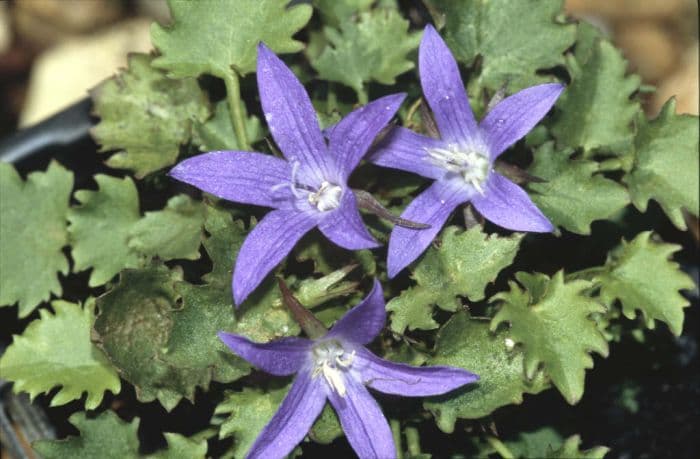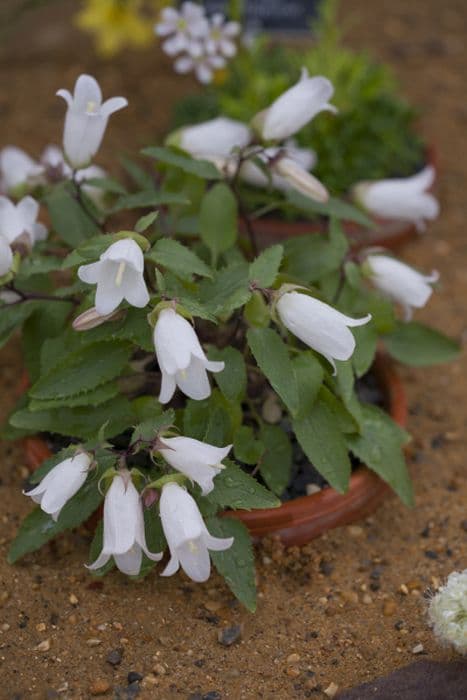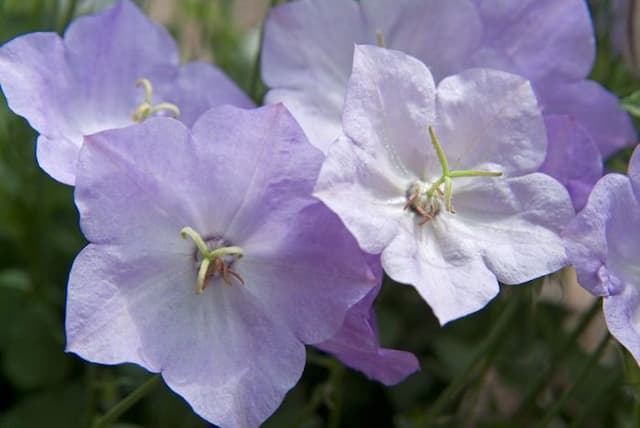Serbian Bellflower Campanula poscharskyana 'Stella'

ABOUT
The plant known as Stella, is a charming perennial that graces gardens with an abundance of starry, blue-purple flowers. These blooms are small and bell-shaped, radiating an almost fairy-tale magic as they cascade freely over green, heart-shaped leaves. The foliage forms a dense mat, providing a lush groundcover that is both beautiful and functional, effectively suppressing weeds. Stella's trailing stems are soft and pliable, assisting in the plant's spreading habit. Its flowers are a true spectacle when in bloom, producing a profuse display that can cover the entire plant. This creates a delightful contrast with the lighter green foliage, which has a slight serration on the edges, giving it additional texture. The blooming period of Stella is notably generous, commonly lasting through the warmer months and providing a long season of visual enjoyment. The flowers can also attract pollinators such as bees and butterflies, adding to the dynamic life in the garden. With its charming demeanor, Stella serves as a versatile plant that brightens up rock gardens, borders, and even containers with its cascading growth and vibrant blossoms.
About this plant
 Names
NamesFamily
Campanulaceae.
Synonyms
Serbian Bellflower, Trailing Bellflower, Blue Waterfall, Poscharsky Bellflower.
Common names
Campanula poscharskyana 'Stella'.
 Toxicity
ToxicityTo humans
The Campanula poscharskyana 'Stella', commonly known as the Serbian bellflower, is not considered toxic to humans. There are no well-documented cases of poisoning from ingesting this plant. However, as with any non-food plant, caution is advised, and it should not be consumed. If any part of the plant is ingested and symptoms develop, medical advice should be sought.
To pets
The Serbian bellflower is considered non-toxic to pets, including cats and dogs. There are no known toxic components that would cause symptoms of poisoning in pets with the ingestion of this plant. However, individual animals may have different sensitivities, and consuming non-food plants can sometimes lead to mild gastrointestinal upset. If any part of the plant is ingested and your pet shows symptoms of distress, it is recommended to consult your veterinarian.
 Characteristics
CharacteristicsLife cycle
Perennials
Foliage type
Deciduous
Color of leaves
Green
Flower color
Blue
Height
0.5 feet (15 cm)
Spread
2 feet (60 cm)
Plant type
Creeper
Hardiness zones
3
Native area
Balkans
Benefits
 General Benefits
General Benefits- Easy to grow: Stella (Campanula poscharskyana) is known for being a low-maintenance plant that thrives without extensive care.
- Drought-tolerant: Once established, it can withstand periods of drought, making it suitable for gardens with less water availability.
- Spreads quickly: It has a vigorous growth habit, providing fast ground cover and suppressing weed growth effectively.
- Attracts pollinators: The flowers attract bees, butterflies, and other beneficial insects, promoting biodiversity in the garden.
- Long flowering period: Stella blooms from early summer through fall, offering a lengthy display of flowers.
- Cold hardy: It can tolerate cold temperatures and is suitable for planting in a variety of climates, including cooler regions.
- Versatile in use: The plant is suitable for rock gardens, borders, and as a trailing plant over walls or in containers.
- Aesthetic appeal: With its profuse, star-shaped blue flowers, it adds visual interest and beauty to any garden setting.
 Medical Properties
Medical PropertiesThis plant is not used for medical purposes.
 Air-purifying Qualities
Air-purifying QualitiesThis plant is not specifically known for air purifying qualities.
 Other Uses
Other Uses- Campanula poscharskyana 'Stella', also known as Starry Bellflower, can be used in fairy gardens for a whimsical touch. Its delicate blue flowers and small size make it an ideal choice for these miniature landscapes.
- Starry Bellflower is suitable for crack filling in rock walls or walkways, as it can grow in very little soil and adds a splash of color to stonework.
- Due to its creeping habit, Starry Bellflower can be used as a ground cover in shaded areas where grass might struggle to grow.
- With its cascading growth, Starry Bellflower makes an attractive "spiller" plant in container gardening, draping over the edges of pots and hanging baskets.
- This plant can be used to add a burst of blue to a floral arrangement as cut flowers due to its long flowering period and copious blooms.
- It's an excellent plant for a child's garden, being relatively easy to grow and maintain while being non-toxic, which makes it safe for curious little ones.
- The dried flowers of Starry Bellflower can be incorporated into craft projects, such as in the creation of natural confetti or potpourri.
- Starry Bellflower can serve as a living mulch, helping to suppress weeds while also keeping soil moist and cool in the summer months.
- Its spread can provide habitat and shelter for beneficial garden insects, like ground beetles and spiders, that help control garden pests.
- Starry Bellflower can be used in "green roofs" or rooftop gardens, due to its low maintenance and ability to withstand some drought once established.
Interesting Facts
 Feng Shui
Feng ShuiThe Serbian bellflower is not used in Feng Shui practice.
 Zodiac Sign Compitability
Zodiac Sign CompitabilityThe Serbian bellflower is not used in astrology practice.
 Plant Symbolism
Plant Symbolism- Constancy and Perseverance: The Campanula family, commonly known as bellflower, symbolizes constancy and perseverance, reflecting the plant's ability to flourish in a variety of conditions.
- Gratitude: Bellflowers are often associated with the feeling of gratitude, making them suitable as a gift to those you are thankful for.
- Unwavering Love: Some cultures view the steadfast nature of the bellflower as a representation of unchanging love and devotion.
- Attractiveness: The delicate and appealing flowers of the Campanula poscharskyana 'Stella', with their star-shaped blooms, can symbolize attractiveness or capturing someone's attention.
 Water
WaterThe Serbian Bellflower, commonly known as Campanula poscharskyana 'Stella', should be watered thoroughly when the top inch of soil feels dry to the touch. Typically, this might be once a week, but frequency can vary depending on environmental conditions and the season. During hot, dry spells, watering may need to increase to twice a week. Use enough water to ensure that moisture reaches the root zone; for potted plants, this may mean using approximately one gallon, depending on the size of the pot. In the winter, reduce watering to prevent the soil from becoming waterlogged, but do not let the plant dry out completely.
 Light
LightSerbian Bellflower thrives best in full sun to partial shade. An ideal spot for ‘Stella’ would be in a location where it receives morning sunlight and some afternoon shade, especially in hotter climates, to protect it from the intense late-day sun. In cooler regions, it can tolerate more sun, and providing ample light encourages better flowering.
 Temperature
TemperatureSerbian Bellflower can survive in a temperature range from 40 to 85 degrees Fahrenheit, making it quite hardy. The ideal temperature range for 'Stella' is between 50 and 75 degrees Fahrenheit. It can withstand even cooler conditions, but for optimal growth and flowering, keeping it within this range is best.
 Pruning
PruningPrune the Serbian Bellflower to maintain its shape and encourage bushier growth. The best time to prune 'Stella' is in early spring or after it has finished flowering. Deadheading spent blooms will promote a second flowering. Generally, annual pruning to remove dead or damaged stems is beneficial, and occasional thinning can help provide sufficient air circulation within the plant.
 Cleaning
CleaningAs needed
 Soil
SoilThe Serbian Bellflower 'Stella' thrives in well-draining soil with added organic matter, such as compost or peat moss, to retain some moisture. A mix of two parts garden soil, one part compost, and one part perlite or coarse sand is suitable. The optimal pH for this plant is slightly acidic to neutral, around 6.0 to 7.5.
 Repotting
RepottingSerbian Bellflower 'Stella' should be repotted every 2 to 3 years to refresh the soil and accommodate root growth. If the plant becomes root-bound or the soil appears depleted, it's time to repot. Best done in spring.
 Humidity & Misting
Humidity & MistingSerbian Bellflower 'Stella' is adaptable to a range of humidity levels and does well in average household humidity. There is no specific humidity requirement, but it appreciates some air circulation.
 Suitable locations
Suitable locationsIndoor
Place Stella in bright, indirect light; water when topsoil feels dry.
Outdoor
Plant Stella in partial shade, sheltered from harsh sun.
Hardiness zone
3-8 USDA
 Life cycle
Life cycleThe life of Campanula poscharskyana 'Stella', commonly known as Serbian Bellflower 'Stella', begins with seed germination, which usually occurs in spring when the temperature and moisture conditions are suitable. The seedlings emerge and establish a rosette of leaves at the soil surface, before developing a robust root system. Throughout the growing season, the plant undergoes vegetative growth, producing more leaves and stems, thus becoming a mat-forming perennial. By late spring to early summer, 'Stella' enters the flowering stage, with star-shaped, lavender-blue flowers blooming prolifically. After pollination, typically involving bees, the flowers produce seed capsules which, when mature, disseminate seeds to propagate the next generation. In autumn, the plant prepares for winter dormancy, with the aerial parts dying back and the roots remaining alive to sprout again in spring, completing its perennial cycle.
 Propogation
PropogationPropogation time
Spring to Summer
The most popular method of propagating the Serbian Bellflower 'Stella', which is a variety of Campanula poscharskyana, involves taking stem cuttings. This is typically done in late spring or early summer when the plant is actively growing. To propagate, you should select a healthy stem and cut a piece about 3 to 5 inches long just below a leaf node. Remove the leaves from the lower half of the cutting to prevent decay when planted. Then, dip the cut end into rooting hormone to encourage root development. Plant the cutting in a pot with well-draining soil, watering it enough to keep the soil moist but not waterlogged. Place the pot in a warm spot with indirect light and maintain humidity around the cutting. Roots should develop within a few weeks, after which the new plant can eventually be transplanted outdoors.









